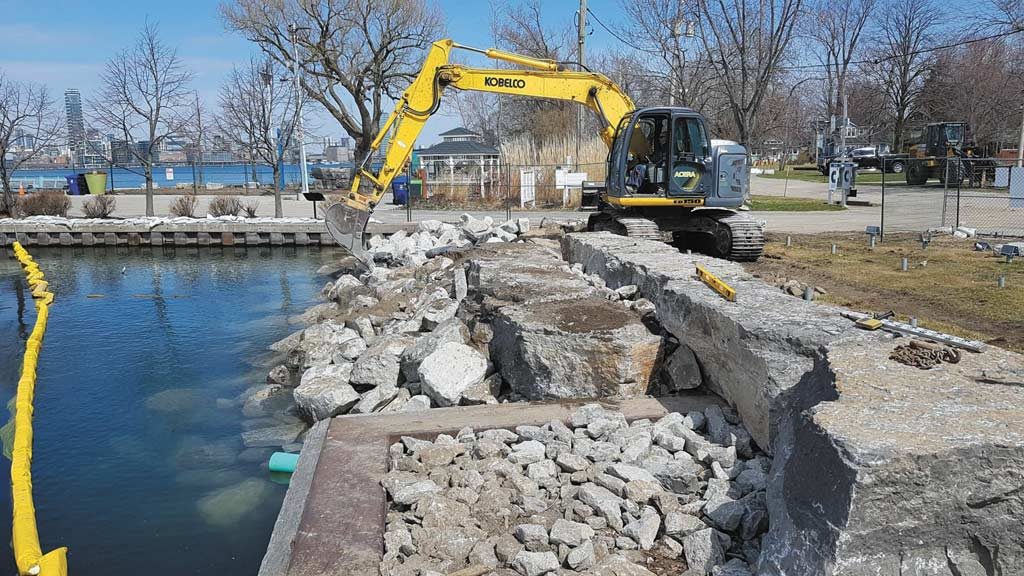Overshadowed by the magnitude of COVID-19, another crisis may be in store for Lake Ontario waterfront communities later this year, which is why the Toronto and Region Conservation Authority (TRCA) has been undertaking a series of proactive flood control measures on the Toronto Islands.
Defined as an essential service under provincial legislation, the flood and erosion mitigation project requires transporting equipment, materials and work crews to the islands, which are a popular day-trip destination attracting thousands of visitors, especially during the summer months.
However, as a result of excessive rainfall in the spring and summer of 2017, there was excessive flooding on the islands and many businesses catering to those visitors had to close for all or most of the season. In 2019, the water levels were even higher and the rainy season longer. But the detrimental effects weren’t as severe thanks to interim measures undertaken by the city and the authority the year before as well as the lessons learned from the 2017 experience, says TRCA senior project manager Jet Taylor.
Now there are concerns those scenarios could be repeated this year. Based on factors such as heavy rainfall, runoff and record high levels in Lake Erie, which inflows into Lake Ontario, the International Lake Ontario-St. Lawrence River Board is predicting high Lake Ontario water levels for this spring and summer.
“The lake is now 22 centimetres higher than it was at the same time in 2019,” says Taylor, underlining the preemptive measures that are intended to provide long-term protection.
Earlier this year the authority hired a number of different consulting firms to prepare flood control and protection plans. Coastal engineering firm Shoreplan Engineering was retained to develop detailed design for defensive walls or “beach curbs” at the heavily used Ward’s Island ferry docks.
Geotechnical engineering firm Grounded Engineering Inc. was retained as the lead consultant for raising portions of two roads on different parts of the islands and an assessment of a seawall on the north shore of Algonquin Island to determine if it should be raised. Its sub-consultant partners include Lithos Group Inc. and W.F. Baird and Associates.
As for the actual construction, it commenced in February and has been restricted to a small workforce to limit COVID-19 spread, says Taylor.
With the assistance of one Valefield Contracting Inc. heavy equipment operator, a TRCA crew built a 75-metre-long backshore beach curb on the east side of the Ward’s Island ferry dock and a second 50-metre-long curb along the shore on the west side.
Consisting of 420 tonnes of armour stone, with individual pieces weighing between three to five-tonnes, and 400 to 500 millimetre riprap, the beach curbs will provide protection to the high-traffic dock terminal, adjacent park paths and other infrastructure. Work on this phase ended at the end of March and in early April the crew began the site set-up for raising the two road sections, Taylor says.
Estimated to take a month to complete and requiring additional workers, the road construction won’t eliminate flooding of those roads. It will, however, raise those sections to a level that will allow emergency vehicle travel including access to a water treatment facility, he says.
Just a sampling of the materials and equipment that has to be delivered to the islands include an excavator, loader, the armour stone, the riprap, silt fencing, recycled concrete and asphalt, says Taylor.
This is a logistical challenge and is being achieved in two different ways depending on the type and amount of material and where it has to go, he says.
“The key is determining the right approach for the specific job,” he adds.
One method is to have delivery trucks drive directly onto ferries heading directly to the project site, but there has to be enough space to lower ramps.
For sites where ramps can’t be used barges are used. An excavator on the mainland loads the material on the barges, while on-board excavators unload it once the barge reaches the islands, he says.
All of the construction is occurring along the Inner Harbour, or north side of the islands where most of the park and emergency service infrastructure is located. The Lake Ontario side is already relatively well protected in many areas by a concrete seawall, says Taylor.
As of mid-April, COVID-19 was having a minimal impact on the pace of the project, which is proceeding according to measures spelled out in a Pandemic Incident Management System Procedure for Field Work manual developed by the TRCA, he says.





Recent Comments
comments for this post are closed